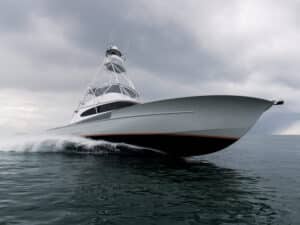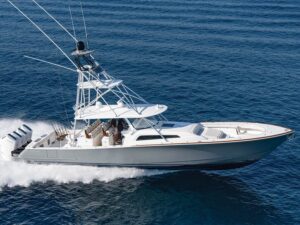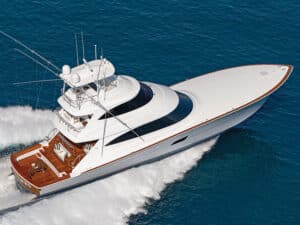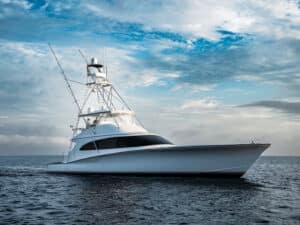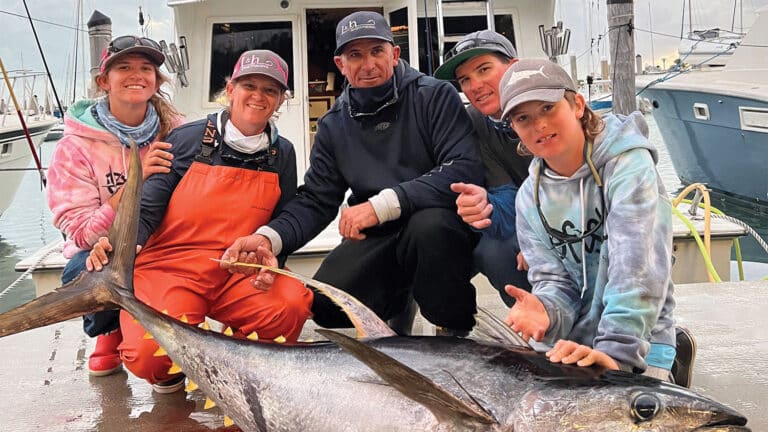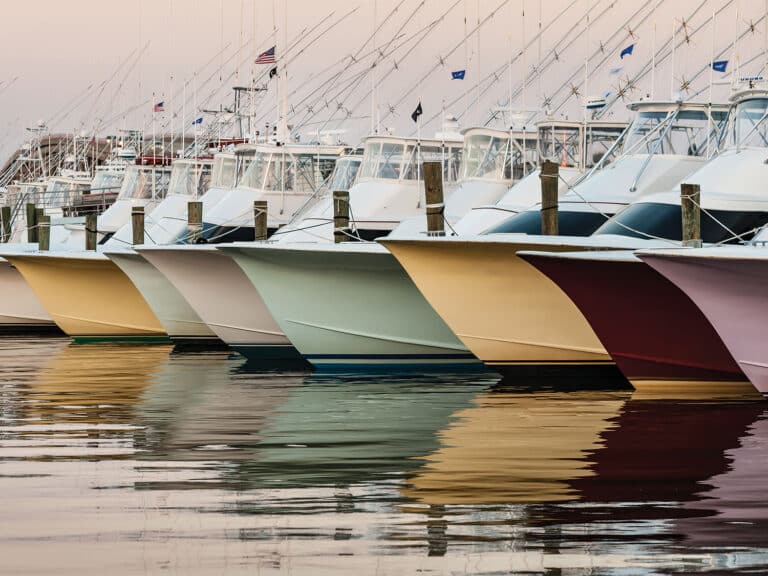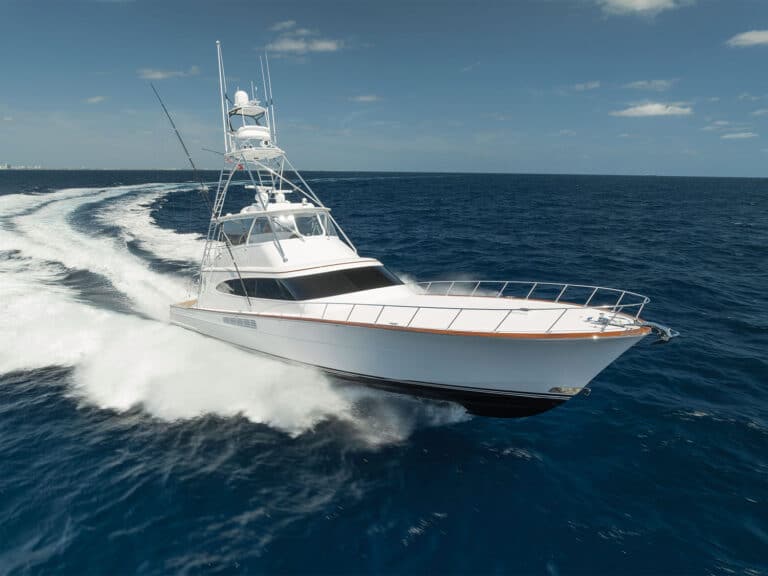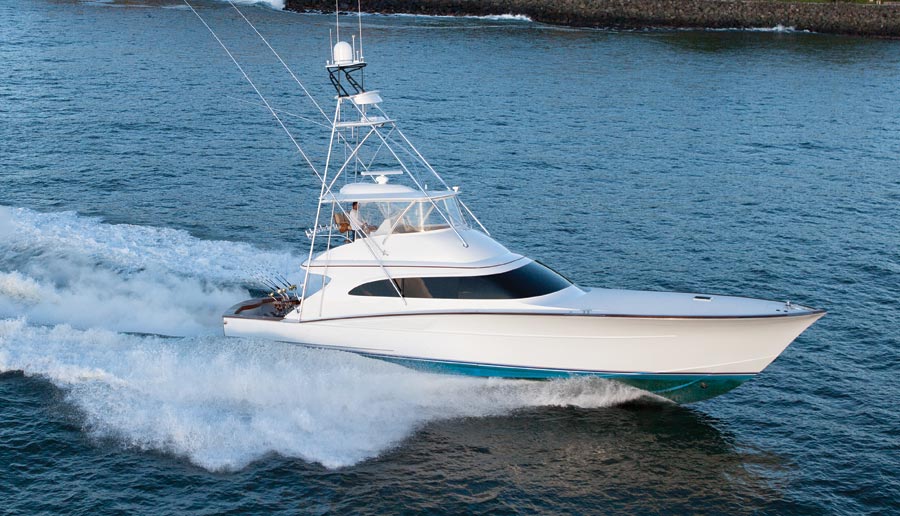
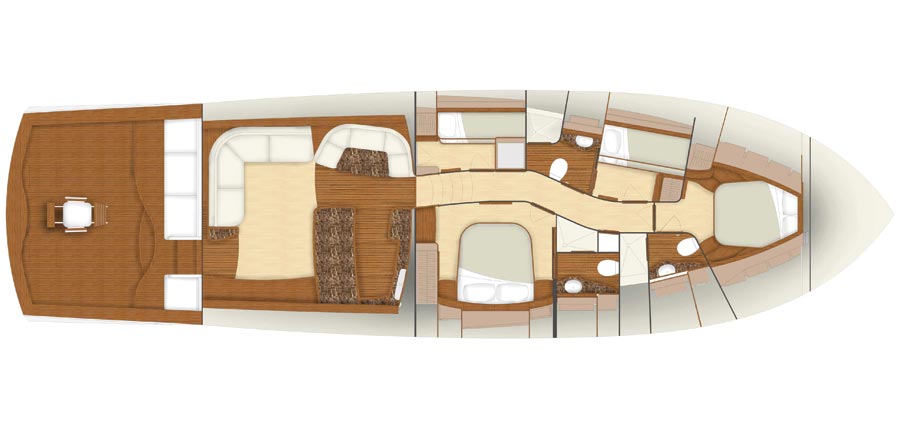
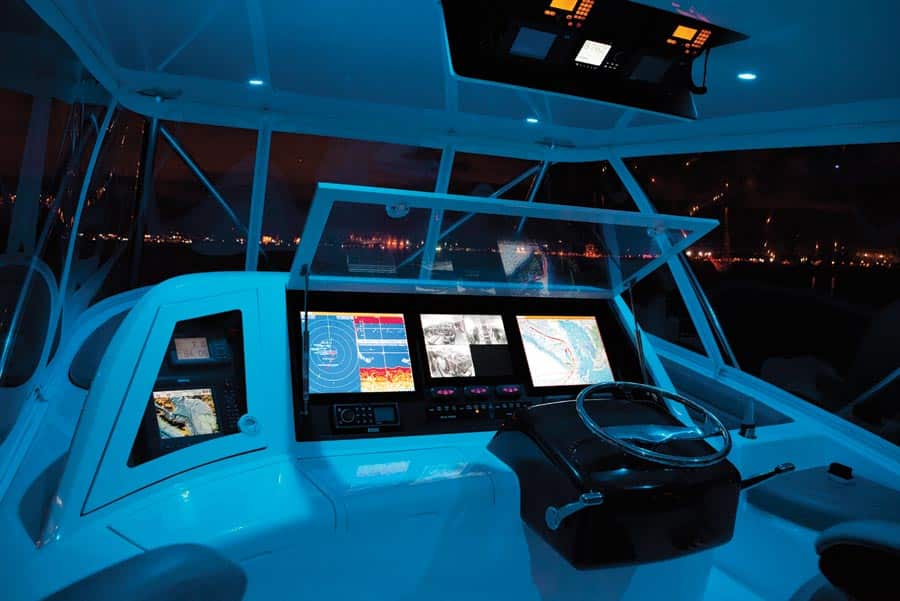
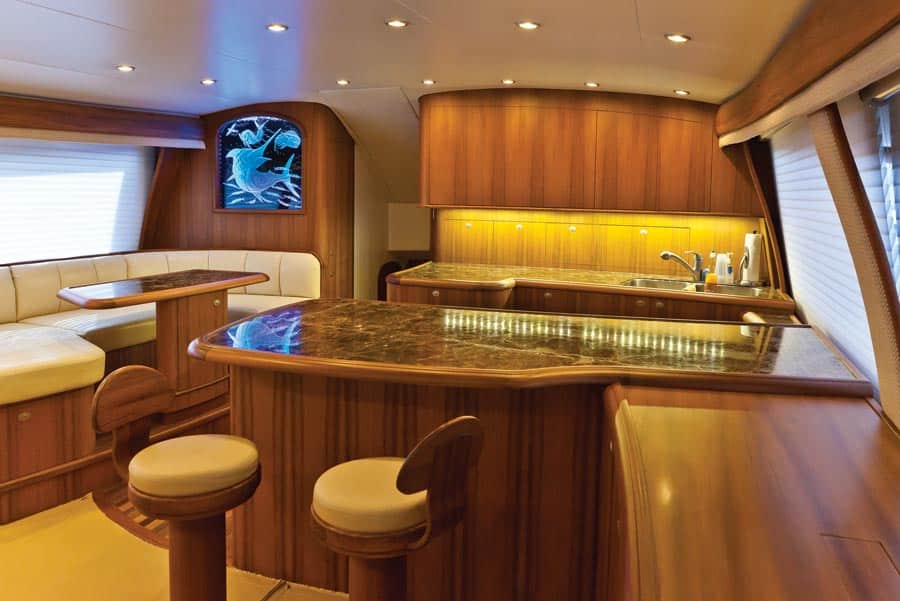
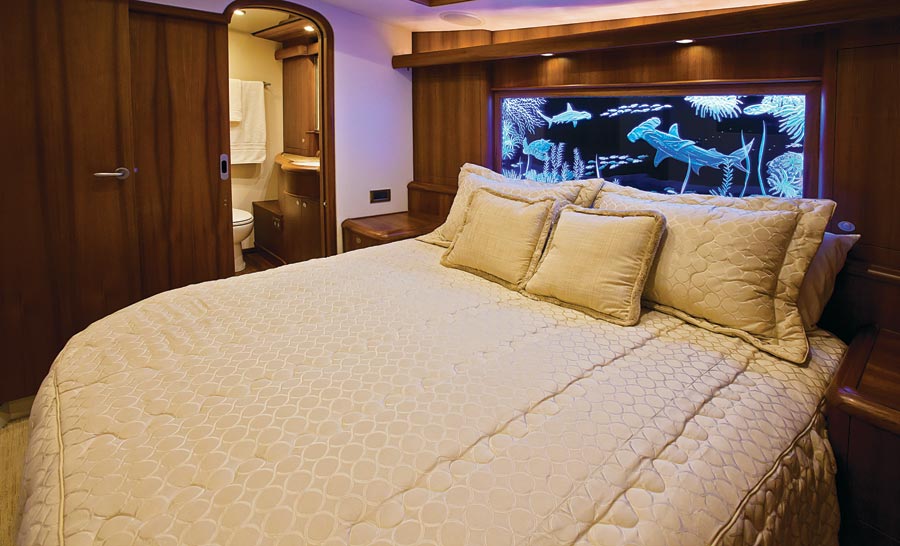
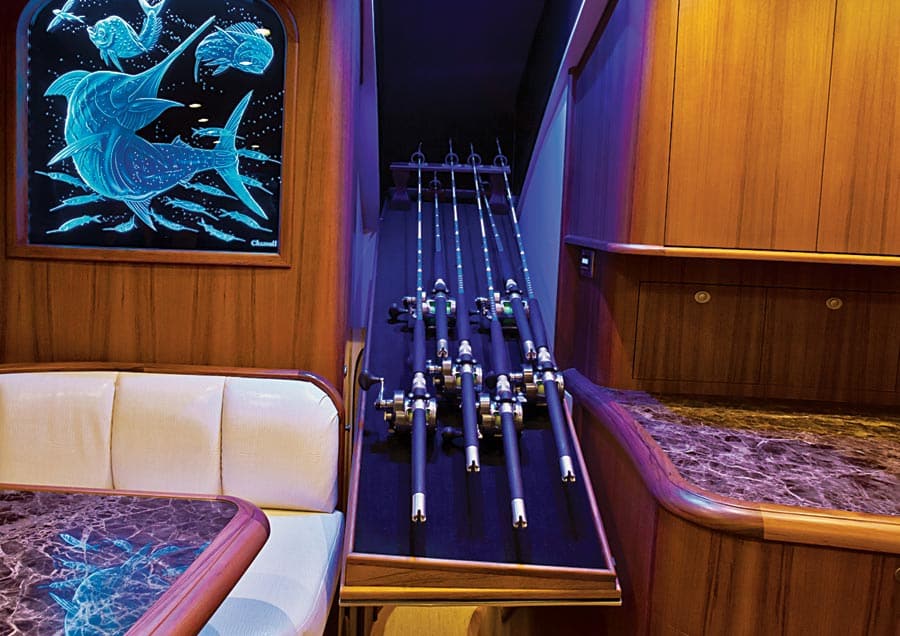
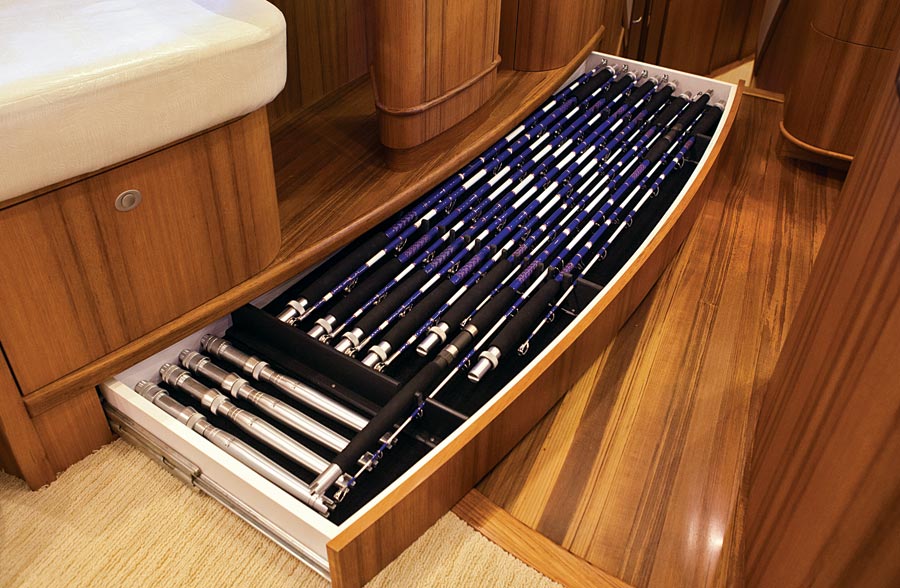
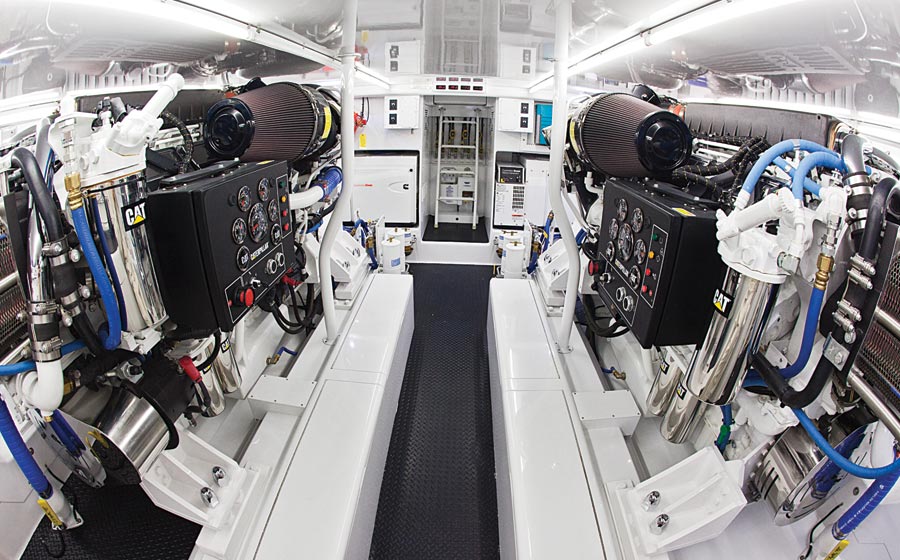

Carolina and Florida builders grab the lion’s share of notoriety for constructing custom sport-fishermen yachts; however, Delaware craftsmen are a group to be reckoned with. Among the notable builders is F&S Boatworks, a family business owned by Delaware native Jim Floyd. His crew, which includes his son Tim and longtime friend Joe Bonvetti, recently delivered the newest launch, the gleaming 66-footer Ay Caramba, to San Juan, Puerto Rico.
“My whole goal was to build the strongest, best-riding cold-molded boat,” Floyd says. Years back, Floyd and a buddy were getting beat up on a rough ride home when he turned and said, “I’ll build you a good boat.” In 1997, after 10 years of development and multiple scale models, his dream — a variable deadrise, longitudinally stepped V (see illustration) 59-foot hull — rolled out of the F&S barn.
Ay Caramba offers up a four-stateroom, three-head layout on this now tried-and-true running surface. This yacht exudes comfort on practically every level. The seas unobtrusively slide beneath her hull from whatever quarter they appear, and she boasts an interior elegance that is simultaneously functional and stunning.
The boat, moored at Club Nautico de San Juan near her 56-foot sister ship, Doña Lucy, would be my accommodations for an overnight stay, thanks to F&S sales manager Roger Casellas. The opportunity to bunk aboard the vessel allowed for more hands-on time to inspect the builder’s attention to detail and see things that are sometimes overlooked during a typical day test. Even better: the fresh dredges and ballyhoo sitting in the cockpit waiting for our sea trial.
“The wind was westerly for the last few days, but today it’s northeast, steady at 12 to 18 knots with nice 5- to 7-footers,” Casellas said. Sporty conditions, but perfect for a test.
He was right, but it wasn’t until the throttles of the potent 1,925 hp CAT C32s were pulled back from 1,800 rpms and 32 knots — the beautiful thing about fishing out of San Juan is that it’s a few short miles to the grounds — that the wave heights became evident. Ay Caramba handled the big, cresting, beam-to/starboard forward-quartering seas so well, when we put the lines in it was a surprise how high up I was looking at the turmoil from the teak-soled cockpit.
**
Fishability**
The 66-footer trolled calmly; it didn’t roll, buck, slosh or tip, no matter what direction we were going — up-sea, down-sea or beam-to. The slow fishing, 3 a.m. wake-up call and 80-degree heat took its toll, however. After enjoying a tasty Cuban sandwich, I could hear the cushy, air-conditioned mezzanine seating calling my name, and a power nap ensued. The large overhang for the mezzanine created a welcome shade from the hot Puerto Rican sun.
Custom means that the builder installs what the client wants. Knowledgeable owners, with the time and resources to invest in these projects, have a standard equipment list on these builds. This is certainly evident in the cockpit area.
Teak adorns gunwales as well as the finely finished aft bulkhead. Fish boxes are appropriately large with ice dumps, the mezzanine steps hold a tournament supply of frozen or refrigerated baits, and other storage areas contain terminal tackle, lures and cold beverages. Gaffs find their place in hidden side cabinets under the gunwales. An outdoor grill slides on rails out of sight when not in use. Release Marine supplied the in-gunwale rod holders and fighting chair: the riggers are Rupps. All snaps, swivels and retrieval lines are within easy reach of the cockpit deck.
A pair of dink dorados popped me up with a jolt, taking the circle-hooked baits for a quick ride before pulling off. With our time up, I climbed the bridge ladder and turned the 66 toward the harbor to find sea heights similar to our departure. I was, I thought, ripping along at a comfortable 30 knots, but Casellas would have none of it. He pushed the throttles up to just shy of 2,100 rpms — near 37 knots — and Ay Caramba blasted through walls of quartering Caribbean Sea. She never launched, and as I braced for that inevitable fall off into the proverbial hole, it never came. Each landing felt as though it was cushioned on air.
Construction
The hull design is an adaptation of a Carl Mosely ocean racer with an early ’60s vintage. Floyd says that this patented bottom helped create SeaCraft boats.
“I grew up on SeaCrafts and said, ‘One day I’ll build a big boat with this hull.’ When the patent ran out, I adapted it to work on a big sport-fish boat. We made minor changes to the original for scale on a bigger bottom,” Floyd says.
F&S is proud to promote their boats as overbuilt and use a thicker stringer system found on boats twice their size. The layup uses three layers of half-inch Okoume plywood on the bottom, with an extra half inch from the forward engine room bulkhead aft, giving more strength to the machinery and stress points of the boat. The bottom is covered with two layers of biaxial cloth and a Kevlar skin.
“The bottom is done in three panels on each side of the solid keel, each at a different angle than the next,” he says. “This adds lift for the hole shot, allows for a soft head-sea ride and beam-to stability. Closest to the keel, the bottom panel is sharp, [the] next not as sharp, then [there’s] a much flatter section allowing for stability. The steps allow air to get underneath for greater efficiency with less horsepower,” Floyd says.
“I refuse to downgrade the size of the stringers. They are solidly built and are the backbone of the boat,” he says. The oversize stringers are produced from solid-laminated, vertical-grain clear Douglas fir.
Matthews Yacht Design computerizes the process of creating the specs for the jigs and superstructure. Mosely — now in his late 80s — still consults on the latest F&S designs.
Ay Caramba’s flying bridge is somewhat smaller than other 66-footers I’ve recently reviewed. Floyd likes for the overall look and the silhouette of his convertibles, including Ay Caramba, to be rounder and futuristically raked, which cuts down on size but increases visibility; you have full view of the cockpit and bow from the helm. There’s still more than seating and storage up above. The Palm Beach hardtop and tower sport the new style curved pipe that flatters the builder’s design concept; Costa’s enclosure kept the wind-blown sea at bay.
“We wanted to establish a look different than the others. The forward flare was cut down a bit; our design is adapted from some of the other Carolina-style boats and created the look we wanted. I like lots of tumblehome and believe a rounded transom performs better backing down,” Floyd says.
Indeed, backing down at 7.5 knots, the water pushed off — rather than over — the transom, and the momentum in reverse had minimal vibration with no chatter from the ZF gears, Veem props or any hatch or appendage on the vessel.
**
Engine Room**
Two egresses allow the crew to access the machinery spaces. The first is from the traditional cockpit hatch, and the second from the crew quarters. The engine room is completely streamlined and the builder places the big diesels low in the compartment to keeping the center of gravity where it needs to be. They are also quite level; F&S uses a 10-degree down angle gear to keep them flat. The engines on Ay Caramba came with a tricked-out chrome package that really added to the look.
For most builders, creating ways to make routine maintenance easier and quicker is now de rigueur. F&S is no exception. There’s a Willy Vac for quick cleanups and a raw water manifold system designed to segregate any individual line with a blockage or issue. That effectively prevents the need to shut down entire systems and makes flushing the hoses of algae in warm-water climates a cinch.
F&S goes to great lengths to hide every wire and hose. “It takes a lot of work,” Floyd says. The engine space is exceptionally well lit, has tool storage and a vise, every compartment is covered, the custom air boxes dissipate the heat quickly, and the sole is free of clutter and knee bangers.
A pump room sits directly under the companionway sole forward, and it’s braced by an additional set of stringers. Two full-size mechanics can fit in the pump room if necessary. The holding tank, water heater, water pumps and an additional 500-gallon fuel cell are contained in this Awlgripped area.
Interior
Ay Caramba is an example of comfort afloat. I worked on my laptop at the dinette, conversed from the salon settee, and had quiet and restful sleep in the forward cabin, and each area revealed nuanced thoughtfulness. The spaces were easy to navigate; there were no tight turns. The builder took full advantage of the interior volume. Drawers, cabinets and doors are plumb and open without obstructions. F&S worked with Belkov Yacht Interiors to create a 3-D model of the interior; from there, Belkov cut all the cabinet boxes.
The teak wood joinery sports a warm satin finish, and the countertops have beautiful marble tops. To starboard, the entertainment center sits concealed behind tightly and precisely fitted cabinetry when not being viewed. The peninsula galley layout offers wide-open food prep areas and entertaining surfaces. A built-in coffee maker automates the morning java, undercounter Sub-Zero refrigerators keep provisions cold, and a wine cooler ensures chilled libations. Top-of-the-line hardware and equipment round out the accessories.
Consistent with the new trend, F&S secures two swivel bar-style stools that create an awesome work or casual dining area. Two stunning pieces of Chris Channells’ glass artwork — one in the salon, the other over the master berth — accent the interior.
The master stateroom has a raised cutout above with valances and is a step down, providing tall-man headroom. The king berth has an electrical lift to access the storage below. My stay in the forward guest stateroom was comfortable and quiet; even with a fresh wind and passing boat traffic, any hull slapping wasn’t enough to disturb this light sleeper.
An Eskimo ice maker, complete teak soles, watermaker, bow thruster with controls in the throttle handles and state-of–the-art ship system controllers add to the functionality of Ay Caramba. She’s truly a complete package — a hull of a boat.
**Specifications
**
LOA: 67’4″
BEAM: 18’11”
DEADRISE: N/A
DRAFT: 4’6″
WEIGHT: 86,000 pounds
FUEL: 2,000 gallons
WATER: 300 gallons
POWER: Two CAT C32 1,925 hp
MSRP: Upon request
_
F&S BOATWORKS / Bear, Delaware / www.fsboatworks.com_
